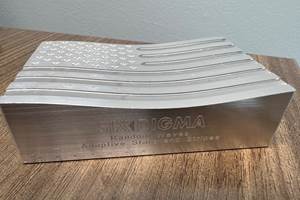MTConnect Moves Ahead
MTConnect is a machine tool communication standard being developed by AMT—The Association For Manufacturing Technology ( www.amtonline.org ). It’s reaching a critical point in its progress. It will soon need some “early adopters” who will embrace the concept, apply it to their products, champion the cause to other
Share





MTConnect is a machine tool communication standard being developed by AMT—The Association For Manufacturing Technology (). It’s reaching a critical point in its progress. It will soon need some “early adopters” who will embrace the concept, apply it to their products, champion the cause to other vendors and promote its benefits to end users. This news is from Paul Warndorf, AMT’s VP of technology, who visited the offices of MODERN MACHINE SHOP recently.
MTConnect is designed to establish specifications for formatting and transmitting data generated by a CNC unit on a machine tool or by other types of automated factory equipment. The concept is simple. Control builders who want to make data such as part counts, cycle times, logs of spindle conditions and so on available to external applications can facilitate this connection by complying with the MTConnect standard. This means tagging and formatting the data according to the rules of the standard. Likewise, software developers with applications that could use this data can adapt their programs to accept it in the MTConnect format. The tags allow the data generated by the control to be located, identified and processed by the developers’ software. Developers are free to analyze and present the data in any form that they believe shops will find useful.
The benefit to end users such as shop owners and plant managers is “plug and play” compatibility. Let’s say a plant has 10 different types of control units on the machine tools out in its shop. To keep track of their performance, managers there want to install a machine monitoring system. For now, the supplier of this system may have to prepare 10 different software interfaces in order to get the machines connected with the new system. The various control unit builders may have to get involved, too, if modifications inside the CNCs are needed.
MTConnect seeks to solve this problem. If both the machine tool and the software application follow MTConnect, as the concept goes, then they are ready to be connected. The control builder has to create only one interface to get data out to any compliant software application, and the software developer has to create only one interface to extract data from any compliant machine tool. Whose make of CNC or brand of software it is shouldn’t matter. This is called “interoperability” in computer circles.
According to Warndorf, the MTConnect development team has settled on XML for these common interfaces. XML is the format used to move numerical data across the Internet, so MTConnect will ensure compatibility with Web-based networking. The next step is to establish what types of data will be covered initially by the standard and to agree on “words” for tagging the different types. Additional “words” can be added later, thus allowing the standard to grow and develop as needed (it’s “extensible,” as they say.) Once the initial set of words is established, control builders and software developers can start on their interfaces.
Warndorf says the plan is to have demos of the standard in action at IMTS 2008. He‚Äôd like to see some big-names among the machine tool companies, control builders and software developers give a high priority to implementing the standard, now that it is this far along. That would give this initiative the momentum it needs to stay on target for the IMTS demos and ultimately to attract widespread adoption of the MTConnect specifications. Overcoming today‚Äôs obstacles to communicating readily with machine tools is seen as an important step to streamlining production and making U.S. manufacturing more globally competitive.For a white paper from AMT on MTConnect, go to Ã˝
Related Content
How I Made It: Amy Skrzypczak, CNC Machinist, Westminster Tool
At just 28 years old, Amy Skrzypczak is already logging her ninth year as a CNC machinist. While during high school Skrzypczak may not have guessed that she’d soon be running an electrical discharge machining (EDM) department, after attending her local community college she found a home among the “misfits” at Westminster Tool. Today, she oversees the company’s wire EDM operations and feels grateful to have avoided more well-worn career paths.
Read MoreInside Machineosaurus: Unique Job Shop with Dinosaur-Named CNC Machines, Four-Day Workweek & High-Precision Machining
Take a tour of Machineosaurus, a Massachusetts machine shop where every CNC machine is named after a dinosaur!
Read MoreBuilding Machines and Apprenticeships In-House: 5-Axis Live
Universal machines were the main draw of Grob’s 5-Axis Live — though the company’s apprenticeship and support proved equally impressive.
Read MoreThe Power of Practical Demonstrations and Projects
Practical work has served Bridgerland Technical College both in preparing its current students for manufacturing jobs and in appealing to new generations of potential machinists.
Read MoreRead Next
Last Chance! 2025 Top Shops Benchmarking Survey Still Open Through April 30
Don’t miss out! 91 ”∆µÕ¯’挀's Top Shops Benchmarking Survey is still open — but not for long. This is your last chance to a receive free, customized benchmarking report that includes actionable feedback across several shopfloor and business metrics.
Read MoreAMRs Are Moving Into Manufacturing: 4 Considerations for Implementation
AMRs can provide a flexible, easy-to-use automation platform so long as manufacturers choose a suitable task and prepare their facilities.
Read MoreMachine Shop MBA
Making Chips and 91 ”∆µÕ¯’挀 are teaming up for a new podcast series called Machine Shop MBA—designed to help manufacturers measure their success against the industry’s best. Through the lens of the Top Shops benchmarking program, the series explores the KPIs that set high-performing shops apart, from machine utilization and first-pass yield to employee engagement and revenue per employee.
Read More






















